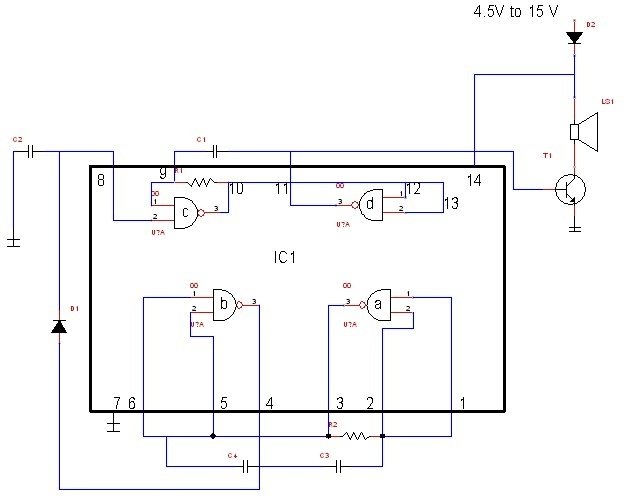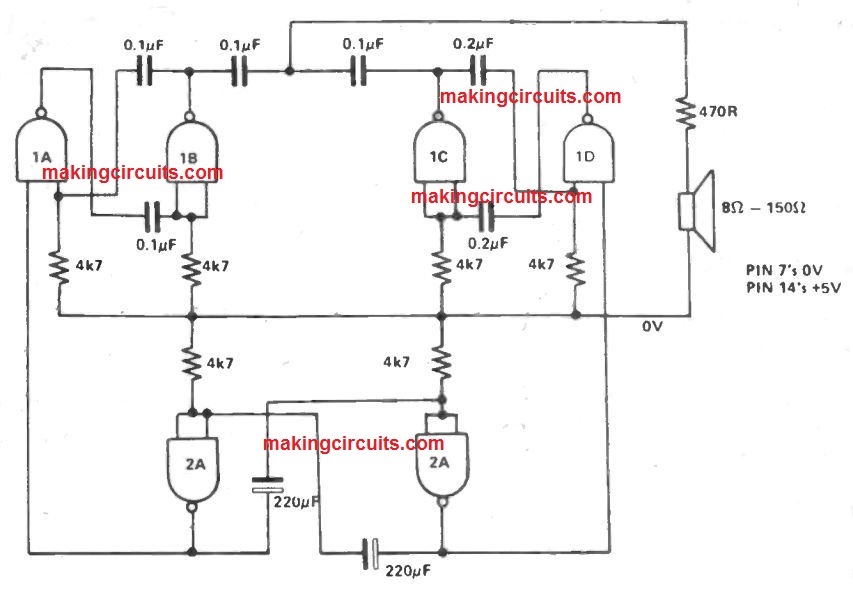This simple electronic siren circuit project aims to explain designing a simple circuit for an electronic siren. It is built on a single chip – CD4011 (IC1). In order to make this work, we need four NAND Gates with 2-input of IC1. Both the gates will be configured to manage high and low frequency oscillator.
The conduction D2 Diode in the circuit responds when there is high output from low frequency oscillator and further enables high frequency oscillator. To change the speed of the oscillator, the value of C3 capacitor can be raised to 8µF.
To tone the changer components, the C1 Capacitor and R1 Resistor are used in this design. Also, in order to let the D1 Diode operate at its full output we have used C2 capacitor. The T1 Transistor in the circuit is used as speaker driver.
Following is a circuit diagram of the electronic siren:

Electronic Siren Circuit Diagram
Here lists below the components that you need to design the project:
Resistors Capacitors Semiconductors Others
R1 = 150 KΩ C1 = 0.015 µF IC1 = CD4011 LS1 = 8Ω speaker
R2 = 500 KΩ C2 = 0.22 µF T1 = BEL187
C3 = 0.5 µF D1 = 1N4148
C4 = 10 pF D2 = 1N4001
NOTE: All resistors should be ¼ watt and ± 5% Carbon.
Siren Circuit using IC 4093
The circuit shown here, despite the frugality, can make quite some noise. This is made possible by the use of T1, an n-channel MOSFET, that works the loudspeaker.

CMOS logic circuits can be used to directly drive the MOSFET. The type used here has an output resistance or drain-source of just 3Ω. On top of that, the drain current can get upto 1.7 A, with the maximum drain-source voltage being 40 V. This does not depend on the polarity of the applied voltage, as there is internal diode protection for the device.
The MOSFET, thus rendered literally undamageable, can be connected to a loudspeaker.
You can control the circuit with a computer. This can be done by making the ENABLE input logic high. Of course, you can use a switch too instead of a computer. On encountering a high input at pin 5 of gate N2, the Schmitt trigger N1 produces pulses that causes N2 to oscillate. The output of N2 acts on the MOSFET, via the buffer N3. P1 is used to control the frequency of N2.
Alarm systems are a great application for this siren circuit.
IC 7400 Siren Circuit
The IC 7400 siren circuit comprises of a couple of oscillators which will produce the tones.

A third oscillator is employed to switch the remaining tones on and off alternately, supplying the two tone output.
By modifying the capacitor values different tones could be generated.
Leave a Reply